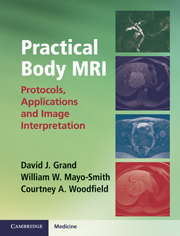Chapter 1 - Introduction
from Section 1 - Body MRI overview
Published online by Cambridge University Press: 05 November 2012
Summary
Introduction
Body MRI is a dynamic, exciting modality. If read carefully, you will find in this small book the essentials to protocol, understand, and interpret abdominal/pelvic MRI. This is not a tome. It is light on physics. This sentence contains the only mention of k-space.
The utility of MRI for evaluation of the chest, abdomen, and pelvis has improved dramatically in the past decade due to more powerful scanners, better pulse sequences, and improved coils. It is the test of choice for evaluation of focal and geographic liver disease and the biliary tree. It is also commonly used to evaluate lesions of the kidneys, adrenal glands, and, more recently, the small bowel. With unparalleled soft tissue resolution, MRI has become the gold-standard imaging exam for evaluation of the female pelvis and staging of pelvic malignancies in either gender.
Fundamentally, MRI remains a problem-solving modality. Exams are/should be targeted to a specific diagnostic problem. The goal of MRI interpretation is to put a diagnostic issue to rest with one final test. It is critical that all previous imaging studies, as well as laboratory data and patient history, be thoroughly reviewed before protocoling and interpreting MRI studies. If the purpose of an exam cannot be determined from all available data, the referring clinician should be contacted.
Information
- Type
- Chapter
- Information
- Practical Body MRIProtocols, Applications and Image Interpretation, pp. 1 - 12Publisher: Cambridge University PressPrint publication year: 2012
Accessibility standard: Unknown
Why this information is here
This section outlines the accessibility features of this content - including support for screen readers, full keyboard navigation and high-contrast display options. This may not be relevant for you.Accessibility Information
- 1
- Cited by
